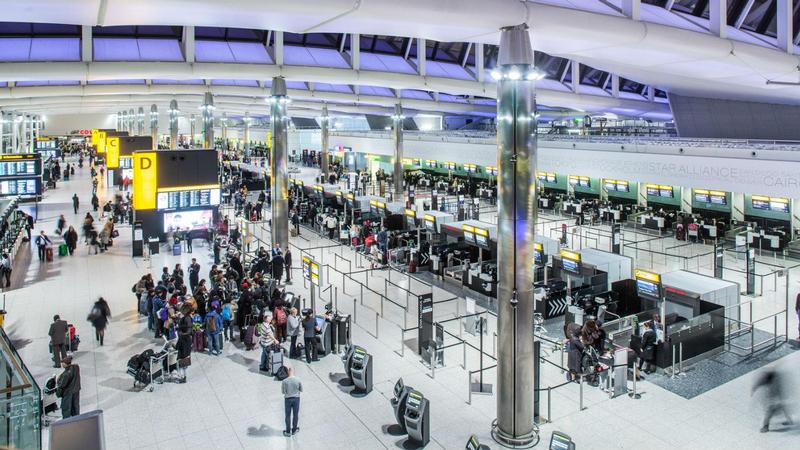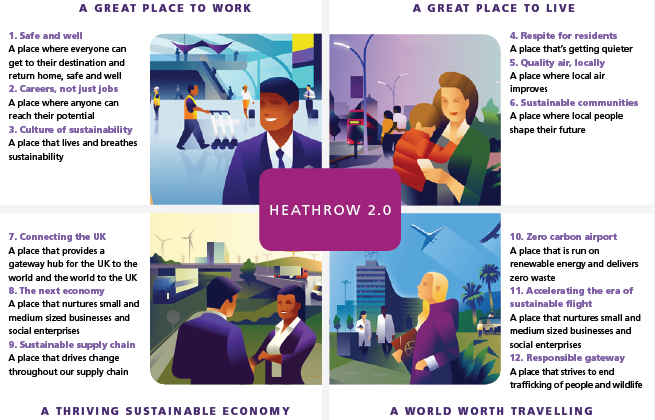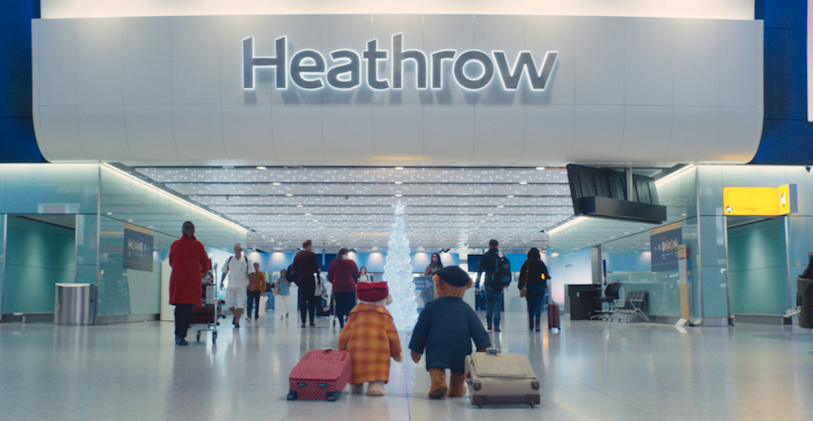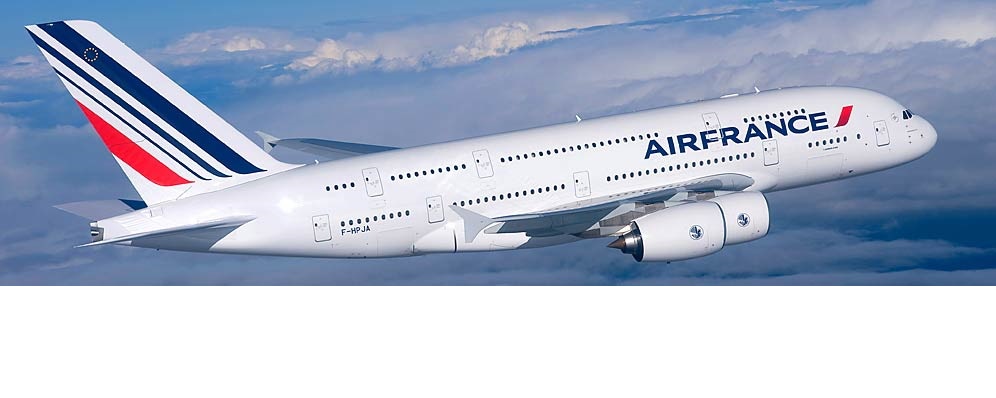Heathrow Airport has released her 2018 sustainability progress report, detailing milestones covered and successes achieved in the organisation’s sustainability strategy entitled, ‘Heathrow 2.0’. Heathrow is the UK and Europe’s busiest airport. In 2018, Heathrow welcomed 80.1million passengers who travelled with 84 airlines to 203 destinations in 85 countries, on 480,339 flights which carried 1.7 million metric tonnes of cargo. With a corporate purpose of making every journey better, Heathrow’s core values include: keeping everyone safe; treating everyone with respect; giving excellent service; working together; doing the right thing; and improving every day. The 2018 report is therefore a social accountability medium about how well the organisation has fared in delivering on the Heathrow 2.0 strategy.
 Heathrow 2.0 is the Airport’s plan for sustainable growth. It sets out how Heathrow intends to improve life for colleagues and communities, contribute to a thriving economy, and help to tackle global challenges including climate change. The plan has four pillars, underpinned by 12 objectives and a range of goals and indicators. It covers our Heathrow’s business as well as the role it will play in driving change across the wider industry. It shows how Heathrow aims to go beyond mitigation and deliver positive impacts that enable the company and her stakeholders to thrive. In clear terms. Heathrow 2.0 is built of four pillars by which the company intends to build:
Heathrow 2.0 is the Airport’s plan for sustainable growth. It sets out how Heathrow intends to improve life for colleagues and communities, contribute to a thriving economy, and help to tackle global challenges including climate change. The plan has four pillars, underpinned by 12 objectives and a range of goals and indicators. It covers our Heathrow’s business as well as the role it will play in driving change across the wider industry. It shows how Heathrow aims to go beyond mitigation and deliver positive impacts that enable the company and her stakeholders to thrive. In clear terms. Heathrow 2.0 is built of four pillars by which the company intends to build:
- A great place to work
- A great place to live
- A thriving sustainable economy
- A world worth travelling

HEATHROW 2.0 2018 ACHIEVEMENTS
- Gender pay gap reduced from 6.53% in 2017 to 0.56% in 2018
- 159 apprenticeship started through the Heathrow Academy
- 604 senior managers trained on sustainability to date
- Responded to recommendations made by the Heathrow Skills Taskforce and launched a new shared apprenticeship scheme
- 33%of senior managers and 43% of all colleagues are women
- 15% of senior managers and 42%of all colleagues are from black, Asian and minority ethnic backgrounds
- Over 100 electric vehicle charging points now installed
- 72 electric and plug-in hybrid vehicles now in Heathrow’s fleet
- 60% of movements by aircraft in the quietest Category
- Received the Wildlife Trust’s Biodiversity benchmark for the 11th year
- Tens of millions of pounds in deals secured by small and medium businesses attending Heathrow’s business summits to date
- Celebrated second year as an accredited living wage employer and published a plan to ensure all direct suppliers also guarantee the Living Wage
- One among only three companies to achieve level 3 carbon trust supply chain accreditation
- Terminal 2 now powered entirely by renewable energy (gas, biomass and electricity), and 100% renewable electricity across the airport since 2017
- 70 hectares of English Peatland restored with the Lancashire Wildlife Trust, through a £94,000 investment match funded by the UK Government
- Published carbon neutral growth roadmap
- Held first team Heathrow forum to tackle illegal wildlife trafficking, followed by a passenger awareness campaign with the UN Environment Programme.
- 7% of our waste was recycled in 2018
MORE INSIGHT ON THE REPORT
The Heathrow 2.0 sustainability report provides an in-depth account of progress against targets for the period 1st January – 31st December 2018. It includes updates on activity planned for 2018, as well as activity due to be delivered in 2019 and beyond where work has already commenced. The data in the report covers Heathrow activities, and in some cases also reflects Team Heathrow activities, where the company is working with business partners who operate at Heathrow to achieve its sustainability goals and targets. The scope of the report relates to Heathrow Airport Ltd and the other businesses operating at Heathrow. In his address to stakeholders at the presentation of the report, Heathrow’s CEO, John Holland-Kaye, remarked, “Heathrow 2.0 is a broad and deep plan for sustainable growth. It sets out how we will address the negative impacts our business can have on communities and the environment, and how we will go even further to deliver positive impact in a way that enables others to thrive as we grow. In this report you can find out more about how we are working together to make aviation sustainable”.
Download the full report here: http://bit.ly/2WlGjrN
ABOUT HEATHROW
 Heathrow is reputed to be the busiest airport in Europe by passenger traffic, and the seventh busiest airport in the world by total passenger traffic. Heathrow was named ‘Best Airport in Western Europe’ for the fourth year running, and ‘Best Airport for Shopping’ for the ninth year in the most recent Skytrax World Airport Awards. Heathrow has two parallel east–west runways along with four operational terminals covering 12.27 square kilometres. It is one of six international airports serving Greater London. In 2018, Heathrow recorded a total passenger traffic of 80.1 million passengers. Heathrow employs over 76,000 personnel across over 400 businesses.
Heathrow is reputed to be the busiest airport in Europe by passenger traffic, and the seventh busiest airport in the world by total passenger traffic. Heathrow was named ‘Best Airport in Western Europe’ for the fourth year running, and ‘Best Airport for Shopping’ for the ninth year in the most recent Skytrax World Airport Awards. Heathrow has two parallel east–west runways along with four operational terminals covering 12.27 square kilometres. It is one of six international airports serving Greater London. In 2018, Heathrow recorded a total passenger traffic of 80.1 million passengers. Heathrow employs over 76,000 personnel across over 400 businesses.
Heathrow Airport is operated by Heathrow Airport Holdings Limited, formerly British Airways Authority (BAA). The company’s head office is located in the London Borough of Hillingdon.

The CSR Arena is a CSR advocacy and sustainability-reporting-analysis champion. We encourage and celebrate effective CSR and positive social impact by responsible corporate citizens; we celebrate international best practices in sustainability reporting across different economic divides. Our goal is to realize the dream of development scholars that, ‘corporates, more than governments, would bring about the much needed sustainable development across the globe. We partner with FBOs, NGOs, CBOs, governments and corporates to spread the message of sustainable development and corporate sustainability. Our platforms bear tales of good corporate citizenship – grab the microphone that you may be heard. Contact: news@thecsrarena.com

